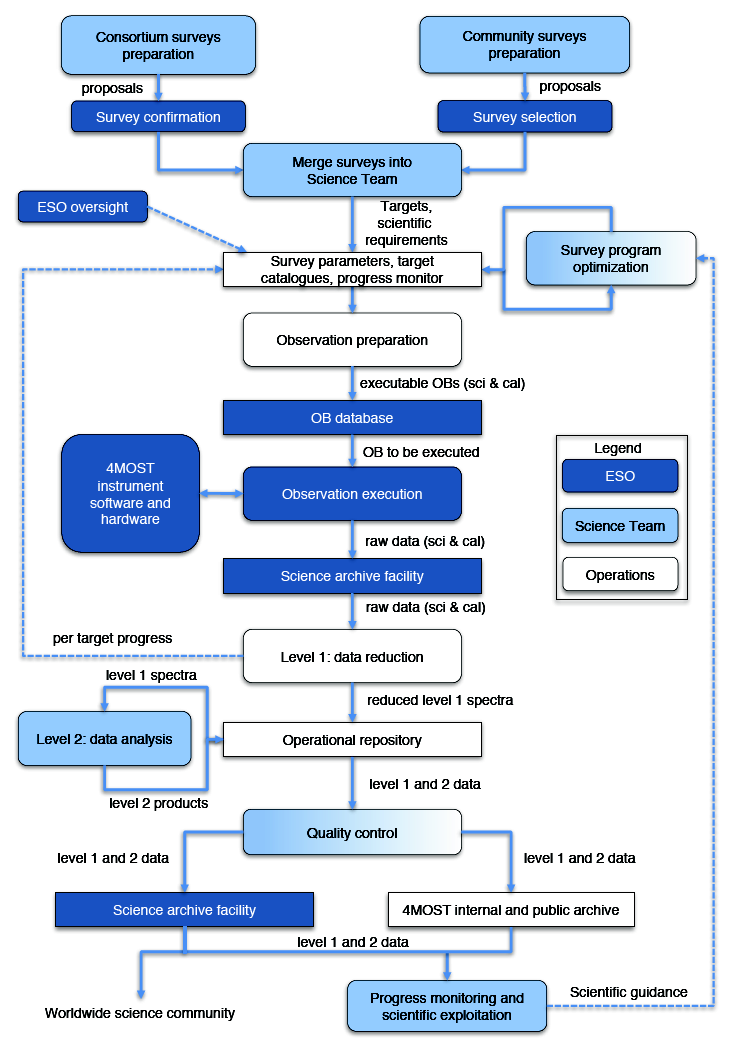Operations Model
4MOST is conceived as a survey facility that comprises the instrument as well as associated operations and data management services. The VISTA telescope will spend 100% of its observing time on Public Surveys with 4MOST for a minimum of 5 years, employing a unique operations concept in which Public Surveys from both the 4MOST consortium and the ESO community will be combined and executed in parallel, with multiple Surveys sharing the available fibres in any given observation.
Importantly, all Surveys executed by 4MOST (irrespective of whether they are Consortium or Community Surveys) will be ESO Public Surveys. That means that all raw data will become public immediately (through ESO's Science Archive Facility), and that all Surveys will have to deliver a set of data products back to ESO for publication (Phase 3), where both the contents of the data set and the schedule of the delivery will have been previously agreed upon by ESO and the Surveys.
Surveys
All Surveys will be executed in parallel, not sequentially. They will pool their targets such that in any given observation 4MOST will typically obtain spectra for many different Surveys simultaneously. Parallel observing enables efficient use of 4MOST for Surveys that have compatible observing conditions requirements and/or a target density lower than the 4MOST multiplexing capability. Note that in this mode, each Survey will only be "charged" the observing time for the fibres actually used by that Survey (including fractional overheads and any residual inefficiencies). This mode does imply, however, that all Surveys will have to agree on a common survey strategy and prepare Observation Blocks (OBs) jointly. As a consequence, all Surveys will have to fully share the raw data as well as the calibrated spectra in order to be able to assess selection functions and mitigate the impact of any cross-talk effect on their science.
4MOST operations have been designed to work within ESO's La Silla-Paranal Observatory framework, with as few changes to infrastructure and processes as possible. Still, two main differences to the standard ESO science operations model are necessary: (1) although each Survey will have submitted its own proposal, from the operations perspective there will only be a single science "customer": the joint 4MOST Science Team, which will comprise all members of all 4MOST Consortium and Community Surveys; (2) common tasks in observation preparation and data management will be centralized and provided by the 4MOST consortium as a service.
Joint Operations Group
4MOST is unique in that its operations will be the joint responsibility of ESO and the 4MOST consortium. The coordination of the various stakeholders in 4MOST operations will be ensured by the Joint Operations Group. The Joint Operations Group will implement the scientific and operational guidance given by ESO, the Survey PIs, and the 4MOST PI. It will include representatives from the various work packages in operations. Its main task will be to ensure that observations for the Surveys progress with the best possible quality over the entire survey duration.
Infrastructure Working Groups (IWGs) perform tasks common to all Surveys. Their members are also members of the Science Team and are delegated to operations. Every Survey team is requested to provide resources to the IWGs. The current working groups are: "Targeting Support", "Survey Strategy and Simulations", "Selection Functions", "Galactic Analysis Pipeline", "Extragalactic Analysis Pipeline", and "Object Classification".
Science Data Flow
The data flow through the 4MOST facility (see figure below) will follow concepts that are familiar to most astronomers working with either ESO or large survey projects. In a nutshell, the following steps in the data and work flow are foreseen:
- Preparation of target catalogues with relevant associated data (e.g. Figure-of-Merit) by Surveys
- Submission of target catalogues to the Operations System run by the 4MOST consortium
- Merging of catalogues and preparation of OBs by the Operations System
- Submission of OBs to ESO
- Execution of OBs at the VISTA telescope by ESO
- Transfer of raw data from telescope to the Data Management System run by the 4MOST consortium
- Data reduction from raw (Level 0) data to calibrated spectra (Level 1 data) by the data reduction pipeline of the Data Management System
- Transfer of reduced (Level 1) data to the advanced pipelines
- Data analysis and creation of advanced (Level 2) data products by advanced pipelines run by the IWGs
- Transfer of all data to archives
- Science exploitation by Surveys and (after a delay) the world-wide community
Note that most of the data flow, including the delivery of data products to ESO (Phase 3), is handled centrally by the Operations and Data Management Systems. Surveys will typically only interact with the data flow by providing their target catalogues and through their participation in the IWGs (who will be responsible for the advanced pipelines).
